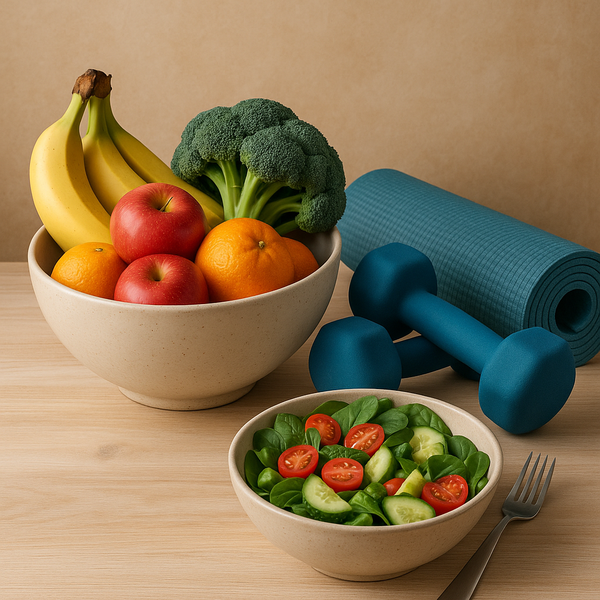
Embarking on a health journey often involves considering both what you eat and how you move. While many focus on one aspect, the true power lies in the synergistic approach of combining diet and fitness. Understanding how these two pillars of wellness interact can significantly enhance your results and lead to lasting health benefits.
Why Combine Diet and Fitness?
Many people view diet and exercise as separate entities, tackling weight loss or health goals by focusing heavily on one while neglecting the other. However, the human body is a complex system where nutrition fuels activity and activity optimizes the use of nutrients. Combining a balanced diet with regular physical activity creates a powerful synergy that is far more effective than pursuing either goal in isolation. Exercise helps burn calories and builds muscle, which boosts metabolism, while proper nutrition provides the energy needed for workouts, supports muscle recovery, and supplies the essential vitamins and minerals your body requires. This combined approach leads to more sustainable weight management, improved cardiovascular health, increased energy levels, better mood, and a reduced risk of chronic diseases like type 2 diabetes and heart disease.
Setting Realistic Goals
Before diving in, it's crucial to set realistic and achievable goals. Instead of aiming for drastic changes overnight, start with small, manageable steps. Define what success looks like for you, whether it's losing a specific amount of weight, improving your endurance, building muscle, or simply feeling more energetic. Use the SMART criteria for goal setting: Specific, Measurable, Achievable, Relevant, and Time-bound. For example, instead of "eat healthier and exercise more," aim for "incorporate three strength training sessions per week and eat five servings of vegetables daily for the next month." Writing down your goals and tracking your progress can provide valuable motivation and accountability.
Nutrition Fundamentals for an Active Lifestyle
Fueling your body correctly is paramount when you're active. A balanced diet should include macronutrients (carbohydrates, proteins, and fats) in appropriate ratios, as well as micronutrients (vitamins and minerals). Carbohydrates are your body's primary energy source, essential for powering through workouts. Opt for complex carbs like whole grains, fruits, and vegetables. Protein is vital for muscle repair and growth, especially after exercise; good sources include lean meats, fish, eggs, dairy, legumes, and plant-based proteins. Healthy fats, found in avocados, nuts, seeds, and olive oil, are important for hormone production and nutrient absorption. Hydration is also non-negotiable; drink plenty of water throughout the day, especially before, during, and after exercise.
Incorporating Exercise into Your Routine
Finding physical activities you enjoy is key to long-term adherence. Aim for a mix of aerobic exercises, strength training, and flexibility work. Aerobic activities like brisk walking, running, swimming, or cycling improve cardiovascular health and burn calories. Strength training, using weights, resistance bands, or bodyweight, builds muscle mass, which increases your metabolism and improves body composition. Flexibility exercises such as stretching or yoga enhance mobility and reduce the risk of injury. Start slowly and gradually increase the intensity and duration of your workouts. Listen to your body and allow for adequate rest and recovery.
Meal Planning and Preparation
Integrating diet and fitness is made much easier with effective meal planning and preparation. Spending a few hours each week planning your meals and preparing some components in advance can save time and help you make healthier choices throughout the week. Prepare lunches to take to work, chop vegetables for quick snacks or dinner additions, and cook staple grains or proteins in bulk. Having healthy options readily available reduces the temptation to grab fast food or convenience items that can derail your progress. Consider tracking your food intake using an app or journal to gain insights into your eating habits and ensure you're meeting your nutritional needs.
Consistency and Listening to Your Body
Building a sustainable healthy lifestyle requires consistency, not perfection. There will be days when you don't feel like exercising or when your diet isn't perfect, and that's okay. The important thing is to get back on track as quickly as possible. Pay attention to how your body feels. Are you experiencing unusual fatigue? Are you feeling overly sore? These could be signs that you need more rest, better nutrition, or a调整 to your workout routine. Learning to listen to your body's signals helps prevent burnout and injury, ensuring your health journey is long and successful. Remember that progress isn't always linear, and setbacks are normal.
Overcoming Common Challenges
Integrating diet and fitness isn't without its challenges. Lack of time is a common barrier. Look for ways to incorporate activity into your daily routine, like taking the stairs or walking during lunch breaks. Short, high-intensity workouts can also be effective. Lack of motivation can be overcome by finding a workout buddy, joining a class, or hiring a trainer. Financial constraints can be addressed by opting for home workouts, outdoor activities, and cooking meals at home instead of eating out. Educating yourself about nutrition and exercise can also empower you to make informed decisions. Don't be afraid to seek guidance from a healthcare professional, registered dietitian, or certified personal trainer if needed.
Combining diet and fitness is not just a strategy for weight loss; it's a holistic approach to achieving optimal health and well-being. By consistently nourishing your body with the right foods and challenging it with regular physical activity, you build a foundation for a healthier, more energetic, and fulfilling life. Embrace the journey, stay committed, and celebrate the progress you make along the way.

